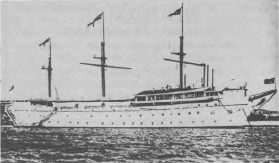- Author
- Swinden, Greg
- Subjects
- Ship histories and stories
- Tags
-
- RAN Ships
- HMAS Tingira
- Publication
- December 1991 edition of the Naval Historical Review (all rights reserved)

At 0800 on 25 April 1912 the White Ensign was raised for the first time onboard HMAS TINGIRA as she lay at anchor in Rose Bay. TINGIRA thus became the third ship to be commissioned into the fledgling Royal Australian Navy (the first two being the Torpedo Boat Destroyers, HMA Ships PARRAMATTA and YARRA).
TINGIRA had previously been the composite clipper ship SOBRAON, constructed in Scotland in 1866 and named after the British victory against the Sikhs at the village of Sobraon, India in 1846. From 1867 until 1891 the SOBRAON traded between Britain and Australia, bringing immigrants, and taking cargoes of wool and wheat on her return voyage to Britain.
In 1891, SOBRAON was sold to the New South Wales government for use as a nautical school ship in Sydney Harbour. The N.S.W. government had begun the nautical school ship concept during the 1870s using the old sailing vessel VERNON as a home and school for Sydney’s wayward youth. Boys who had committed pretty crimes or had no means of support were placed onboard her and underwent basic schooling and trade training. In 1891 the VERNON was replaced by the SOBRAON. From 1891 until 1911 the SOBRAON was moored off Cockatoo Island and over 6000 boys passed through her training system.
In 1911 the system of retraining the wayward youth of N.S.W. was changed and the nautical school ship was sold to the newly created RAN (the boys from SOBRAON were transferred to the new institution at Mount Penang near Gosford).
The RAN decided that the SOBRAON would be renamed to prevent any confusion between her role as a reform school for wayward boys and that of her new role as the boys training ship of the RAN. TINGIRA is an aboriginal word meaning “open sea” and is pronounced TIN-GUY-RA.
The 1910 Henderson Naval Mission to Australia had recommended that Australia train its own personnel for service in its own navy. Thus a naval college to train officers and a boy’s training ship to train sailors were established.
In June 1912 the first 100 boys joined the training ship. Boys between the age of 14½ and 16 were enlisted for seven years service in the RAN (from 1920 the period of service was increased to 12 years). The period of service did not begin until the boy reached the age of 18 at which time he was promoted from boy to ordinary seaman.
Upon joining the TINGIRA (commonly known throughout the Navy as the TINNY or the OLD TIN DISH) the boys were rated as boys 2nd class, and began their training in basic schooling and seamanship. After three months of training which included climbing the rigging barefooted, splicing, bends and hitches, boat-work, basic engineering and classroom work in mathematics and English the boys moved on to gunnery training.
Gunnery training was conducted ashore at the naval reserve at Rose Bay called Lyne Park. Here boys learnt to drill with the .303 rifle, strip down 6 inch guns and haul field guns over the sand dunes to Bondi. One old TINGIRA boy remembers this of his gunnery training – We were told on our first day – “we don’t want you to walk, we don’t want you to run, we want you to fly”.
Any infringement in training would earn the boy a lap of the park at the double carrying a 6 inch shell. Other punishments in the TINGIRA included caning (until 1919 when it was banned), kit musters at lunchtime, and all instructors carried stonickys (a rope with a monkey’s fist on one end) which they used against a boy’s buttocks if they thought he was slow in carrying out an order.
Boys were trained firstly as seaman, but could specialise as writers, victuallers, signallers or after a period of service afloat they could become stokers. Only the more intelligent boys became signallers and they underwent further training at Williamstown Naval Depot or Flinders Naval Depot (HMAS CERBERUS) from 1921 onwards.
Over 3000 boys passed through the TINGIRA from 1912 until she was decommissioned in 1927. These boys saw service in both world wars, the Korean War and the Malayan emergency.
During World War I boys served in Australian warships during the capture of German New Guinea in 1914. They were aboard HMAS SYDNEY at her clash with the EMDEN on 9 November 1914 off the Cocos Islands. Boys served in the North Sea, Mediterranean, Atlantic, Indian Ocean and South East Asian waters.




